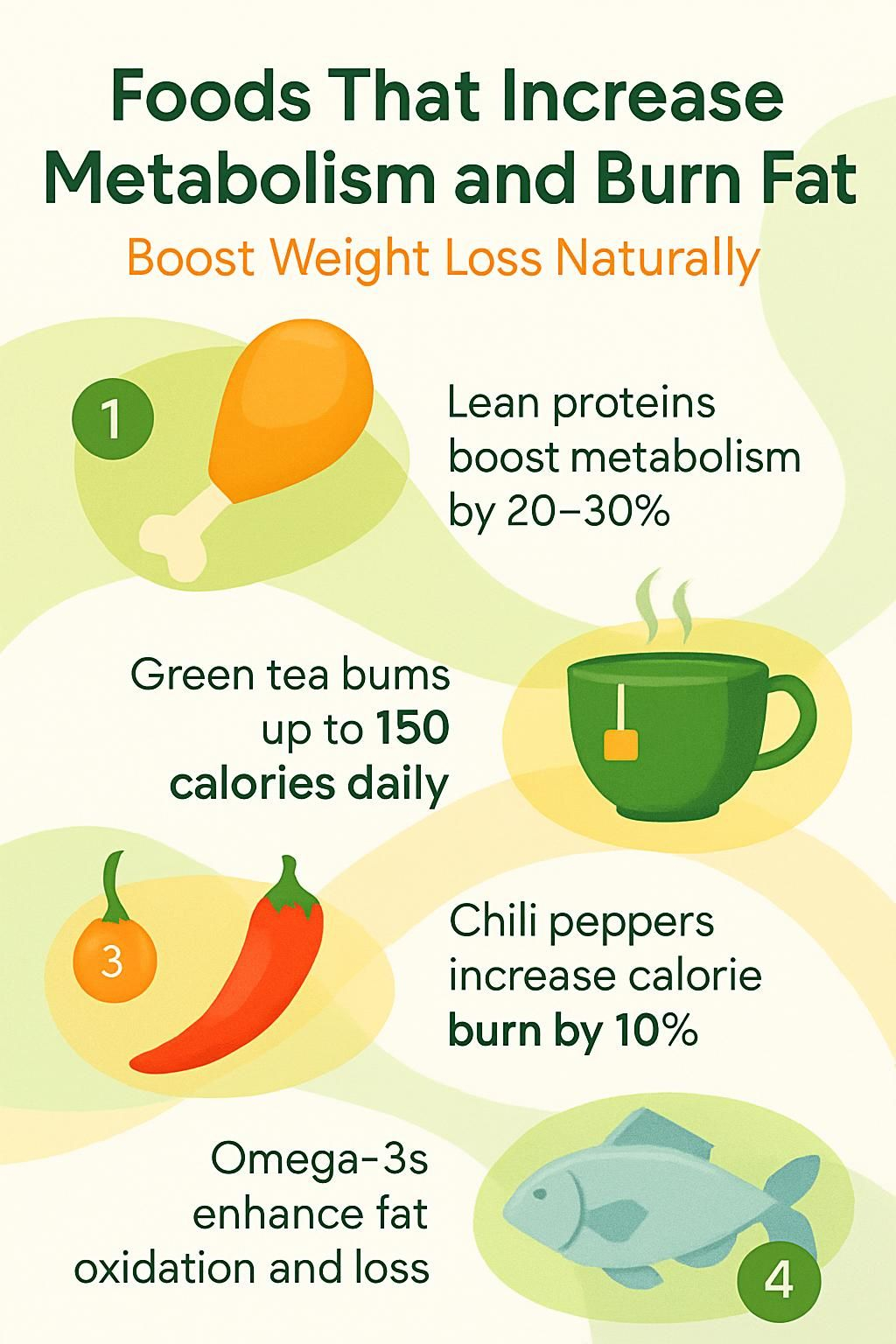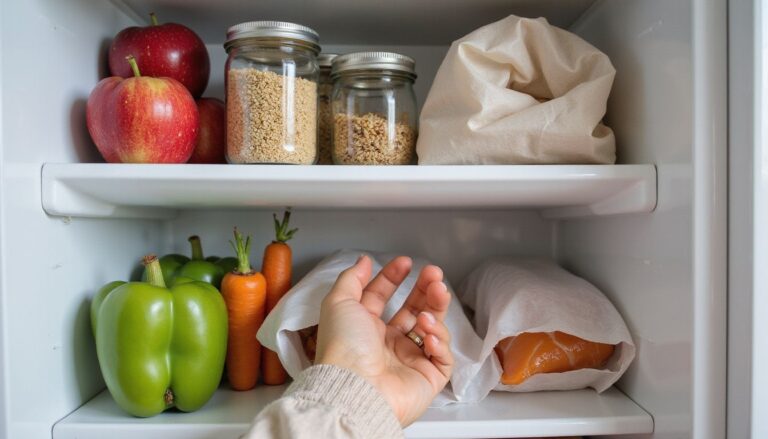Foods That Increase Metabolism And Burn Fat: Boost Weight Loss Naturally
Our Nutrition Assistant AI Suite will transform your body. You will lose fat, get toned, and build muscle. Gain confidence and optimal health.
Losing weight can feel slow when your body conserves energy. Eating metabolism-boosting foods helps your body burn more calories, even at rest. Research links certain foods and drinks, such as green tea and lean proteins, to a higher metabolic rate and steady progress with weight loss [1].
This guide explains which foods and drinks support a faster metabolic rate, why they work, and simple ways to use them in daily meals. Small changes stack up. Start with one or two swaps, then build from there.
…
[1] Dulloo AG et al., “Green tea and thermogenesis: interactions between catechin-polyphenols, caffeine and sympathetic activity,” Physiol Behav. 2000;68(6):731–738.
Key Takeaways
- Lean proteins, including chicken, fish, and yogurt, can raise calorie burn by 20 to 30 percent during digestion due to the thermic effect of food (Mayo Clinic).
- Green tea and coffee may add about 43 to 150 extra calories burned per day from catechins and caffeine, supporting weight loss (Dulloo AG et al., Boschmann et al., 2003).
- Spices such as chili peppers and cinnamon support thermogenesis, which increases heat production and calorie use. Chili peppers can raise post-meal burn by up to 10 percent (British Journal of Clinical Nutrition).
- Whole grains, oats, and legumes promote fullness and require more energy to digest than refined grains, which may support reductions in abdominal fat over time (2017 findings).
- Omega-3 fatty acids from seafood improve how cells use fat for fuel, which can raise resting energy use and assist fat loss (2015 evidence).

What is metabolism and how does it affect weight loss?

Metabolism is how your body turns food into energy for every task you do. A faster metabolic rate means you burn more calories, which can make weight control easier.
What does metabolism mean?
Your metabolism converts the food you eat into usable energy. This energy powers breathing, digestion, thinking, and even sleep. The number of calories you burn at rest is called your basal metabolic rate, or BMR. Muscle mass, age, hormones, and genetics all influence BMR.
Protein-rich foods like lean meat, beans, and Greek yogurt can boost your metabolism because they take more energy to digest than fat or carbohydrates. After I added more protein and fiber-rich foods to my meals, my energy felt steadier through the day.
The human body burns about 60 to 75 percent of its daily calorie needs through basic metabolic functions, according to the Mayo Clinic.
How does metabolism influence fat burning and energy levels?
Metabolism sets the pace for how quickly you burn calories and fat. A higher rate helps you use more energy even at rest. The body spends extra energy digesting protein, which is called the thermic effect of food.
Foods that rev up your metabolism, such as green tea and chili peppers with capsaicin, can support fat burning and alertness. Exercise, especially strength training, builds muscle that uses more calories all day. A nutrient-dense eating pattern also supports thyroid hormones that regulate energy and hunger.
Best foods to naturally boost your metabolism
Certain foods can speed up metabolism for several hours after you eat. They also help you feel full longer, which supports a consistent weight loss journey.
Why are lean proteins important for metabolism?
Lean proteins such as chicken breast, fish, eggs, and cottage cheese require more energy to digest. This rise in energy use is the thermic effect of food. Protein digests slower than refined carbs, so it also supports steady energy and fewer cravings.
You can burn 20 to 30 percent of protein’s calories during digestion. Carbs average 5 to 10 percent, and fat is even lower. Try adding tuna, lentils, or yogurt to bowls, soups, and snacks to support muscle and boost your metabolism for a few hours after eating.
How do fish and shellfish enhance metabolic rate?
Seafood like salmon, tuna, shrimp, and crab provides high-quality protein that raises calorie burn during digestion. Many fish also supply omega-3 fatty acids, which can increase fat oxidation, the body’s process of using fat for fuel.
Shellfish such as oysters and mussels offer iodine and selenium, two minerals that support a healthy thyroid. Since the thyroid helps control your metabolic rate, including seafood two times a week can be a smart step for weight management and health.
Can legumes and beans help increase metabolism?
Legumes and beans, including chickpeas, kidney beans, and lentils, are rich in protein and dietary fiber. Your body spends more energy digesting these foods than it does with refined grains and sugary snacks.
Fiber feeds your gut bacteria, which produce short-chain fatty acids that may support metabolic health. Many people feel fuller longer after meals with beans. I noticed fewer afternoon cravings once I started adding beans to lunches. Pair lentils or kidney beans with brown rice to also boost iron and magnesium intake.
How do eggs support metabolism and fat burning?
Eggs deliver complete protein that raises calorie burn through the thermic effect of food. Studies show a breakfast with eggs can increase fullness and reduce later calorie intake. Eggs also contain vitamin B12, which helps convert food into energy.
Compared with many breakfast options, eggs are nutrient-dense and satisfying. Some research suggests that an egg-based breakfast may improve weight loss during an eight week period.
Spices and ingredients that raise your metabolic rate
Think of spices as tiny sparks that nudge your metabolism higher.
How does capsaicin in chili peppers boost metabolism?
Capsaicin is the spicy compound in chili peppers like jalapeño and cayenne. It can increase heat production, known as diet-induced thermogenesis. That process raises energy use and calorie burn.
People who eat capsaicin may burn up to 50 extra calories per day. One study found a 10 percent increase in post-meal calorie burn after chili pepper. Spicy foods can also slow eating, which helps fullness cues kick in. I like chopped chili in soup or stir-fry for a warm, energizing lift.
What are the metabolic benefits of cinnamon?
Cinnamon may help your body manage sugar more efficiently, which keeps insulin responses steadier. In a 2017 review, one to six grams per day was linked to lower fasting blood sugar.
This spice may also support thermogenesis, which increases calorie burn. Try adding cinnamon to oatmeal or smoothies. It brings flavor with virtually no calories and may help curb cravings.
Can ginger increase your metabolic rate?
Ginger contains compounds such as gingerol and shogaol that may raise calorie burn and reduce hunger. In one small 2018 study, adults who ate ginger with a meal burned up to 43 more calories than those who did not.
Grate fresh ginger into stir-fries, tea, or smoothies. Many people report feeling warmer or more energized afterward. A simple slice in hot water can be an easy daily habit.
How does black pepper affect metabolism?
Black pepper has piperine, a compound that may support thermogenesis. This can slightly increase daily energy use. Piperine may also influence genes related to fat storage.
A sprinkle of ground pepper adds flavor without extra calories. I often add it to eggs or steamed vegetables for taste and a small metabolic nudge.
Which drinks help increase metabolic rate?
Smart drink choices can support calorie burn and appetite control.
How does green tea boost metabolism?
Green tea contains catechins, antioxidants that may raise resting energy expenditure, which is how many calories you burn at rest. Some people may burn about 43 extra calories per day from green tea.
Caffeine in green tea is a gentle stimulant that can improve fat oxidation during exercise. Aim for 2 to 3 cups a day to support metabolism while staying hydrated.
Can coffee increase your metabolic rate?
Caffeine stimulates the central nervous system and often increases metabolic rate by 3 to 11 percent for a short time. Depending on your size and intake, that can equal 70 to 150 extra calories burned in a day.
Many people feel more focused and energized after a cup. Caffeine may also help the body use stored fat for fuel during activity. The effect is stronger if you do not already drink coffee often.
What are the benefits of oolong tea for metabolism?
Oolong tea contains both caffeine and catechins. Studies suggest it can raise energy expenditure by about 2.9 percent over 24 hours, roughly 67 extra calories for many adults.
Oolong may also support fat oxidation. I swapped my afternoon drink for oolong and felt more alert, with fewer evening snacks. Pair it with water through the day to maintain hydration.
Why is water important for metabolism and fat burning?
Water supports every metabolic step, from moving nutrients into cells to clearing waste. Cold water may raise calorie burn slightly as your body warms it to core temperature. In one study, about 500 milliliters increased metabolic rate by roughly 30 percent for up to 40 minutes.
Staying hydrated helped me cut cravings while aiming for weight loss goals. Choosing water over sugary drinks also keeps digestion smooth and calorie intake in check.
Reference: Boschmann et al., Journal of Clinical Endocrinology & Metabolism, December 2003.
Fruits and vegetables that improve metabolism and fat burning
Colorful produce delivers fiber, water, and micronutrients that support a healthy metabolism.
How do leafy greens like spinach and kale affect metabolism?
Spinach and kale are low in calories and high in fiber, vitamins, and minerals. Fiber requires more energy to digest, which slightly increases calorie burn. These greens also provide magnesium and iron that support many metabolic reactions.
They act as prebiotics, which feed the helpful bacteria in your gut. That supports digestion and energy balance. Adding a handful to omelets or smoothies is a simple daily upgrade.
Can apples and pears help increase metabolism?
Apples and pears are hydrating and rich in fiber that supports fullness. A medium apple has about 4 grams of fiber. A medium pear has about 5 to 6 grams.
Both contain vitamin C and potassium. Studies report that daily intake of apples or pears may help reduce body weight across several weeks¹². I often swap cookies for an apple or pear, which keeps cravings down without losing satisfaction.
…
1: https://pubmed.ncbi.nlm.nih.gov/15191351/
2: http://apjcn.nhri.org.tw/server/APJCN/16/4/705.pdf
What metabolic benefits do berries provide?
Berries are loaded with polyphenols, which are antioxidants that may help the body use fat for fuel. In a 2019 study, a daily cup of blueberries improved insulin sensitivity and lowered inflammation, two markers tied to better metabolic health.
They are also high in fiber, which supports fullness and gut health. I like mixed berries on yogurt or oats for steady morning energy and fewer cravings.
How do grapefruit and watermelon support fat burning?
Grapefruit delivers vitamin C and fiber that support balanced blood sugar. In one 12-week study, eating half a grapefruit before meals was linked to greater weight loss.
Watermelon is low in calories and high in water, which helps fullness. It contains citrulline, an amino acid that may support blood flow and energy use during exercise. A bowl on summer mornings helps me stay hydrated and avoid heavy snacks.
Whole foods and grains that enhance fat burning
Whole grains and minimally processed foods support steady energy and a healthier metabolic rate.
Why is quinoa good for boosting metabolism?
Quinoa is a seed rich in protein, fiber, and minerals like magnesium. One cup of cooked quinoa has about 8 grams of protein, which raises calorie burn during digestion and supports muscle.
Its complex carbohydrates provide steady energy without sharp spikes. I replaced white rice with quinoa in salads and felt full for hours with better afternoon focus.
How do oats contribute to metabolic health?
Oats are high in soluble fiber, including beta-glucan. This fiber supports stable blood sugar and longer-lasting fullness. One cup of cooked oats has about 4 grams of fiber and roughly 150 calories.
They also feed gut bacteria, which can support how your body uses fat. After moving from sugary cereal to oatmeal, my mid-morning cravings dropped and my focus improved.
Can whole-grain bread help increase fat burning?
Whole-grain bread offers complex carbohydrates and fiber that digest slowly. Your body works harder to break them down than refined bread, which can slightly raise calorie burn.
In a 2017 study, people who ate whole grains saw greater reductions in abdominal fat than those who ate refined grains. Choose options with whole grain as the first ingredient, then pair with protein to extend fullness.
Healthy fats that support metabolic functions
The right fats support hormones, cell health, and sustained energy use.
How do omega-3 fatty acids from fish improve metabolism?
Omega-3s from salmon, sardines, and tuna help your mitochondria, the tiny energy factories inside cells, work more efficiently. Better mitochondrial function means your body burns more calories, even when you rest.
Omega-3s also support fat oxidation and may reduce inflammation that interferes with metabolic health. After adding fish twice a week, many people notice steadier energy and less midday hunger.
What role do nuts and seeds play in metabolism?
Nuts and seeds supply healthy fats, protein, and fiber that support appetite control and blood sugar balance. Almonds, walnuts, chia seeds, and flaxseeds also provide magnesium and vitamin E.
A small handful can keep you satisfied, and some calories in nuts are not fully absorbed. I carry a small container of almonds to help avoid vending machine snacks.
How does medium-chain triglyceride (MCT) oil affect fat burning?
MCT oil is digested differently than most fats. It goes straight from the gut to the liver, where it is quickly used for energy or made into ketones. Studies suggest MCTs can increase daily calorie burn compared with long-chain fats.
| Fat Source | Extra Calories Burned per Day | Fat Used as Fuel |
|---|---|---|
| MCT Oil | About 120 | Higher |
| Long-chain Fats | About 0 to 30 | Lower |
Some research shows that having MCT oil before exercise can increase fat use during activity. Start with a small amount, such as 1 teaspoon, to check tolerance.
What are the advantages of eating metabolism-boosting foods?
These foods can raise calorie burn during digestion, support fat use for energy, and help you stay satisfied between meals.
How do these foods increase calorie burn during digestion?
Foods like lean proteins, beans, and whole grains have a higher thermic effect of food, meaning your body spends more energy to digest and process them. Protein has the largest effect, about 15 to 30 percent of its calories.
Adding chicken, lentils, or Greek yogurt to meals can leave you full and warm as your body uses extra energy to digest. That steady burn adds up over time.
In what ways do they enhance fat oxidation for energy?
High-protein foods maintain muscle mass, which supports a higher resting metabolic rate. Spices and drinks such as chili peppers, green tea, and coffee contain compounds like capsaicin and caffeine that encourage thermogenesis and fat oxidation.
In The American Journal of Clinical Nutrition, green tea was linked with up to a 17 percent increase in fat burning during exercise. After a breakfast of eggs and spinach, you may feel energized longer because protein signals the release of stored fat into the bloodstream for fuel.
How do metabolism-boosting foods improve appetite control and satiety?
Protein, fiber, and water-rich foods slow digestion. This helps manage blood sugar and reduces hunger swings. In a 2013 study, higher protein intake led to a 15 percent rise in reported fullness.
Simple swaps can help. Eggs or oatmeal at breakfast and quinoa with almonds at lunch often lead to fewer snacks and more consistent energy.
How can you maximize the benefits of metabolism-boosting foods?
Pair smart food choices with daily movement and practical habits for the best results.
Why combine these foods with regular exercise?
Exercise raises energy needs during and after the workout. Strength training builds muscle that burns more calories at rest. Eating protein after lifting weights supports repair and recovery, which increases energy use.
Consistent training, plus protein, whole grains, and produce, supports long-term weight management and health.
How does maintaining a balanced diet support metabolism?
A balanced diet provides the protein, healthy fats, fiber, vitamins, and minerals your body needs to run metabolism efficiently. It also helps you maintain muscle mass and stable blood sugar.
Include a mix of lean proteins, whole grains, vegetables, fruits, and healthy fats. Stay hydrated, since water helps your body burn calories more effectively.
Why is controlling portion sizes important when eating these foods?
Even nutrient-dense foods can stall progress if portions are too large. Nuts and seeds are healthy but calorie-dense. One ounce of almonds has about 164 calories.
Use smaller plates, measure servings, and build meals around protein and fiber. This approach delivers benefits without excess calories.
Conclusion
Choosing foods that increase metabolism and burn fat can help you move toward your weight loss goals. Lean proteins, produce, whole grains, healthy fats, and low-calorie drinks increase daily energy use while keeping meals satisfying.
Evidence shows these habits can raise calorie burn, support fat oxidation, and improve appetite control. Start with one change, such as swapping refined grains for oats or adding green tea at lunch. If you have a medical condition or take medication, talk with a healthcare professional before major diet changes.
With steady steps and smart choices, you can boost your metabolism naturally and feel more energetic each day.
FAQs
1. What are metabolism-boosting foods and how do they help burn fat?
Metabolism-boosting foods are items that can increase the rate at which your body burns calories. Incorporating metabolism-boosting foods such as lean proteins, green tea, and chili peppers may support fat loss by raising energy use during digestion or increasing thermogenesis. Studies show that protein-rich meals can raise metabolic rate by up to 30 percent for a few hours after eating.
2. How does incorporating metabolism-boosting foods into my diet support weight loss naturally?
Incorporating metabolism-boosting foods helps your body use more energy even while at rest. For example, research published in The American Journal of Clinical Nutrition found that people who consumed capsaicin from chili peppers experienced increased calorie burning compared to those who did not include these spices in their diets.
3. Are there scientific studies supporting the benefits of these foods for weight management?
Yes, several peer-reviewed studies confirm the effects of certain nutrients on metabolic rates and fat oxidation. For instance, a review in Obesity Reviews reported that green tea extract could enhance fat burning during moderate exercise sessions.
4. Can you share a personal experience with incorporating metabolism-boosting foods?
After adding more high-protein options like eggs and Greek yogurt to my breakfast routine, I noticed feeling fuller longer throughout the morning; this made it easier to avoid snacks before lunch. This simple change helped me maintain steady progress toward my weight goals without feeling deprived.
Summary: Metabolism-boosting foods play an important role in natural weight management strategies when included regularly as part of balanced meals; credible evidence supports their effectiveness for enhancing calorie burn and promoting satiety.







